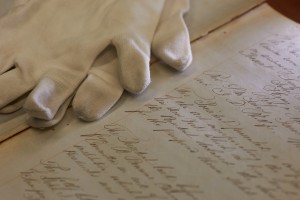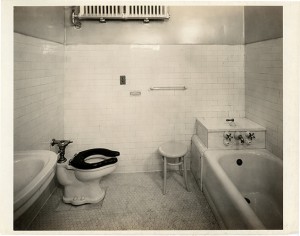Dec 31, 2015
Every New Year brings expectations of new beginnings: new projects, new historical resources, and new historical insights we never imagined. We are sure 2016 will be no different, so what might we expect?
In 2016, the Mount Sinai Archives will become the official repository of the historical collections documenting the long histories of St. Luke’s and Roosevelt Hospitals. These will be transferred to Mount Sinai in the spring, and work will begin to catalog and make the content known and available to the public.
As noted in a previous blog, in February or March we will roll out a new, much improved website. This will provide much better access to our archival material, including a page featuring our always expanding digital collections. One piece of that is our audio-visual collection, and that will grow again soon as we process another batch of recently digitized tapes.
In 2016 we also hope to begin a long anticipated project to make available some of the Mount Sinai oral history collection. This includes interviews with Mount Sinai personalities, primarily physicians, as well as taped events, meetings, grand rounds presentations, investitures, and history of medicine at Mount Sinai lectures. This is a complex project to make the sound available and link it to transcripts where they exist, but we hope that 2016 will be the year that this process begins.
So, Happy New Year to you, and our best wishes for a fun and productive 2016.
Dec 9, 2015
The staff of the Mount Sinai Archives is hard at work pulling together text and images for a new Archives website to replace our existing 1999 era, fully Y2K compliant web pages. This has meant reviewing the current content, editing it where needed and trying to find the perfect images that are wide and not tall, and that will get across the theme of each page. Should the pictures be old and classic looking to show that we care for historical material? Or should they be all modern and techie to show our efforts to move our collection to the digital age? And what about the information itself? Which sections deserve their own pages, and which can be handled in a drop-down box?
All of these are questions we are working through right now. We will submit our first draft to the Mount Sinai web team next week, and then it will be up to them to design it into a coherent, eye catching whole. Watch for our new website in February or early March of 2016. The one thing we are certain of: the new website will be a big improvement over our current site!

Hmm, would this make a good website photo?
Nov 19, 2015
November 18th is World Toilet Day, a phrase that seems strange – and funny! – to the ears. So, first some fun. Below are images of the fancy new bathroom, including a toilet, that Mount Sinai Hospital offered to the well-to-do paying patients in the new Private Pavilion that opened in 1921. It does not look like much today, but it had all the pieces and could be kept ‘sanitary,’ which was an important goal.
Which leads to the unfunny part about World Toilet Day. It exists for a reason. As the website for World Toilet Day notes: “Of the world’s seven billion people, 2.4 billion people do not have improved sanitation. 1 billion people still defecate in the open. Poor sanitation increases the risk of disease and malnutrition, especially for women and children.” (http://www.worldtoiletday.info/about)
Think about it, and go to the website to learn more.


For more on the Archives or the history of Mount Sinai, contact us at msarchives@mssm.edu
Nov 10, 2015

The Class of 1905, where the first Nancy was a student.
This week I spent some time looking for an early graduate of The Mount Sinai Hospital School of Nursing. An email about the alumna, Nancy Morris, said she graduated from the School in the late 1890s. As I scanned the class lists trying to find the exact year of her graduation, I found many names that seem distinctly old-fashioned, but no simple Nancys. There was a Josepha, many Adas and Idas, an Alphasine, a few Mauds and Daisys, a Mehitable, an Igogereth, quite a few Minnies and Mabels, a Mynolia, and some Florences. It was 1905 – 24 years into the School’s history – before I found the first Nancy, and they were few and far between for quite some time after this.
Just as an FYI, the most common name in our School of Nursing up until 1910 was Mary. This did not even make the top 50 girls’ names in 2013, according to Parents magazine.
Nov 4, 2015
Fifty years ago, on November 30, 1965, the first Deans of the new Mount Sinai School of Medicine were installed. These men were: George James, MD, MPH, Dean of the School of Medicine, as well as the founding chairman of the Department of Community Medicine (today’s Preventive Medicine department); Irving Schwartz, MD, Dean of the Graduate School of Biological Sciences and Chairman of the Department of Physiology; and Hans Popper, MD, PhD, Dean for Academic Affairs, Chairman of Pathology, and a pioneer hepatologist. At the investiture ceremony held to mark the occasion, many statements and promises were made about the future of the new school. With hindsi ght, we can see that many of these not only came true, but remain relevant today.
ght, we can see that many of these not only came true, but remain relevant today.
Gustave L. Levy, Chairman of the Board of Trustees at Mount Sinai, noted that it was important that the school would have courses not only in the biomedical sciences, but also in the social sciences and humanities. This emphasis on the value of the humanities has had an up and down history at Mount Sinai, but it was revived again in 1987 with the creation of the Humanities in Medicine program and today’s expanded FlexMed admission program, as well as the 2012 creation of the Academy for Medicine & the Humanities. George Baehr, MD also spoke at the event about the value of the social sciences. He graduated from Mount Sinai’s house staff in 1908 and led the First Medical Service at Mount Sinai for many years. Baehr led Mount Sinai’s World War I unit and later created HIP for his friend and patient, Mayor LaGuardia. Dr. Baehr said in his remarks that it was important that medical students be exposed to the humanities and community medicine, because it will “hopefully keep our faculty and students from forgetting that the primary purpose of all this is the care of the sick, the preservation of health, and the amelioration of human suffering.”
Finally, Dr. James outlined standards that have guided Mount Sinai over the last 50 years. He said Mount Sinai has “four separate responsibilities”: “We must constantly be humble, we must constantly welcome criticism, be critical of ourselves, and be ready to change. The second responsibility we have is that of relevance… We must always remain part of the community. We must always be alert to the solution of the problems which are current in the community, and in the world… It is essential that this institution remain relevant to the health problems of our era, no matter what they be – and they will change – and no matter what problems are brought to us in the years to come. The third responsibility we have… is the responsibility for excellence. We are not privileged to follow in the footsteps of those who went before if we will not accept this challenge for excellence. There must be no compromise with it, no compromise under any circumstances. One final responsibility that we must assume… is the responsibility of leadership. … The institution has prided itself by being always among the forefront of medical care and research institutions, and those of us associated with it must be prepared to at least try to carry it to new heights.“
For more on the Archives or the history of Mount Sinai, contact us at msarchives@mssm.edu






